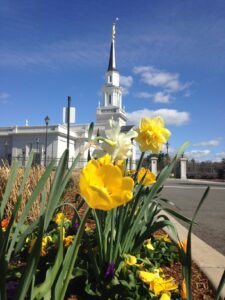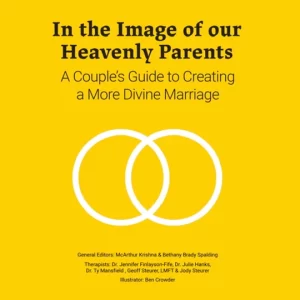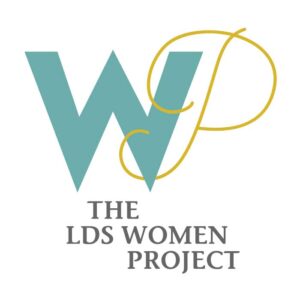I spoke in church on Mother’s Day (May 14, 2023) about the Latter-day Saint doctrine of a Mother in Heaven. Here’s the speech:

In Cherish: The Joy of Our Mother in Heaven, p.8
Good afternoon, and Happy Mother’s Day!
An online institute teacher said recently that sacrament meeting talks tend to fall into two categories: good news and good advice. Good news talks bear testimony. Good advice talks discuss principles and different ways to put them into practice. I would like to focus on the good news of Mother’s Day.
Elder James E. Talmage stated this GOOD NEWS in the spring 1902 general conference:
“The Church [of Jesus Christ of Latter-day Saints] is bold enough to go so far as to declare that man has an Eternal Mother in the Heavens as well as an Eternal Father.”[1]
Sister Patricia Holland, counselor in the Young Women general presidency in the 1980s, added this:
“I have heard it said by some that the reason women in the Church struggle to know themselves is because they don’t have a divine female role model. But we do. We believe we have a Mother in heaven … Furthermore, I believe we know much more about our eternal nature than we think we do, and it is our sacred obligation to express our knowledge, to teach it to our young sisters and daughters, and in doing so, to strengthen their faith and help them.”[2]
This doctrine of having a Heavenly Mother is not just for our young sisters and daughters. The Family Proclamation in 1995 opened with this:
“All human beings—male and female—are created in the image of God. Each is a beloved spirit son or daughter of heavenly parents, and, as such, each has a divine nature and destiny.”[3]
We are ALL children of heavenly PARENTS. So I hope the men will tune in better, rather than thinking this talk is irrelevant to them. It is important and essential for EVERYONE.
In April 2022 general conference, Elder Renlund taught about being children of God and named our Mother in Heaven:
“We have heavenly parents, a Father and a Mother. The doctrine of a Heavenly Mother comes by revelation and is a distinctive belief among Latter-day Saints. … Very little has been revealed about Mother in Heaven, but what we do know is summarized in a gospel topic found in our Gospel Library app.”[4]
He didn’t go into any details of the gospel topic essay, but his statement is that it is our doctrine. The Church website, in the introduction to the grouping of essays, says this:
“The purpose of these essays, which have been approved by the First Presidency and the Quorum of the Twelve Apostles, has been to gather accurate information from many different sources and publications, and place it in the Gospel Topics section of ChurchofJesusChrist.org, where the material can more easily be accessed and studied by Church members and other interested parties.”[5]
So, this is considered foundational doctrine of our Church.
Prior to the talk by Elder Renlund, I had known about Heavenly Mother. I’d had some very strong spiritual experiences that confirmed to me that this is a doctrine to treasure, that Heavenly Mother is a divine being worth developing a personal relationship with, that I needed to study this more. I had not, however, read the Gospel Topics essay and it was barely on my radar that it existed at all. I’m told that when the series of essays were released in 2016, seminary classes were encouraged to read them, but I don’t remember any kind of announcement directed to adults that they were released and should be studied.
So after that talk, I went into the app and found the essay – if you’d like to read along, go to the Library home page, choose Gospel Topics, and choose “Mother in Heaven.” I was, I admit, not impressed – it’s only six paragraphs and I read it in about a minute. I was feeling frustrated when I had a picture come to my mind of starting blocks for a sprint race.
When I was in high school, I ran the stopwatch for the sprinters on the track team. A starting block is at a 45-degree angle for the bottom of a runner’s foot, with only their toes actually on the ground. They lean down onto their fingertips with their rear end in the air and their head down. For a race that lasts less than 30 seconds, they spend two to three minutes getting set on the block, because if they’re not positioned correctly, they will launch onto their face.
I realized that the Mother in Heaven essay is a starting block. We believe in continuing revelation and eternal progression, so presumably the race we are getting set for is related to that. But we have to get set on the block before we start the sprint, or we’re not going to get anywhere and instead we will make a huge mess of things.
Sarah Granger Kimball, the woman who founded the organization in Nauvoo that became the Relief Society, and was a prominent Relief Society leader in Utah, said this:
“They that seek, by faith and earnest prayer, find the light that leads to the golden gate. They that knock with study and faith’s assurance have the narrow way opened to them and are received into communion with the Infinite Father and Mother.”[6]
That sounds fantastic to me, so I started looking a lot more closely at the Gospel Topics essay about Mother in Heaven. There are multiple doctrinal statements in it, and there are 17 footnote references that include scriptures, general conference talks, and extensive historical documents.
I want to point out footnote 2, which includes a BYU Studies project titled “A Mother There.” In 2008-9, a team at BYU did extensive research into Church history to document when leaders have taught about Heavenly Mother or referred to Heavenly Parents. Their findings were published in 2010, and they had located more than 600 references to Mother in Heaven from Joseph Smith through 2010. There have been more since then. This paper was the basis of the Gospel Topics essay.[7]
So let’s read it.[8]
Paragraph 1: The Church of Jesus Christ of Latter-day Saints teaches that all human beings, male and female, are beloved spirit children of heavenly parents, a Heavenly Father and a Heavenly Mother. This understanding is rooted in scriptural and prophetic teachings about the nature of God, our relationship to Deity, and the godly potential of men and women. The doctrine of a Heavenly Mother is a cherished and distinctive belief among Latter-day Saints.
We learn from this paragraph again that we have heavenly parents – Father AND Mother. ALL people are their children and can have a relationship with them. We are loved by them. All people have eternal potential for progression. This is most definitely a distinctive belief – recently a Harvard professor, who is Jewish, was interviewed by some LDS podcasters, and the professor said that the doctrine of Heavenly Mother has the power to be our most effective missionary tool. People want to know about the feminine side of God, and we are one of the few faiths that even believes that it exists.[9]
And this is cherished. How do you cherish things? Some people keep their cherished things very personal and private, other people splash it all over social media with poetry and visual arts. My kids are starting to get annoyed that I cherish Heavenly Mother with art – I just got another one? Yep. When I was a young adult, church members were encouraged to cherish the temple by having art of the temples in every room of our homes. I see this as no different.
Paragraph 2: While there is no record of a formal revelation to Joseph Smith on this doctrine, some early Latter-day Saint women recalled that he personally taught them about a Mother in Heaven. The earliest published references to the doctrine appeared shortly after Joseph Smith’s death in 1844, in documents written by his close associates. The most notable expression of the idea is found in a poem by Eliza R. Snow, entitled “My Father in Heaven” and now known as the hymn “O My Father.” This text declares: “In the heav’ns are parents single? / No, the thought makes reason stare; / Truth is reason—truth eternal / Tells me I’ve a mother there.”
Paragraph two confirms that historically, this teaching goes all the way back to Joseph Smith. We of course know of the Eliza R. Snow poem that became the hymn “O My Father,” but did you know that W. W. Phelps, who wrote the hymn “Come, Come Ye Saints,” also wrote poetry stating our belief in Heavenly Mother. It’s in the essay footnotes.
Paragraph 3: Subsequent Church leaders have affirmed the existence of a Mother in Heaven. In 1909, the First Presidency [Joseph F. Smith, John R. Winder, Anthon H. Lund] taught that “all men and women are in the similitude of the universal Father and Mother, and are literally the sons and daughters of Deity.” Susa Young Gates, a prominent leader in the Church, wrote in 1920 that Joseph Smith’s visions and teachings revealed the truth that “the divine Mother, [is] side by side with the divine Father.” And in “The Family: A Proclamation to the World,” issued in 1995, the First Presidency and Quorum of the Twelve Apostles declared, “Each [person] is a beloved spirit son or daughter of heavenly parents, and, as such, each has a divine nature and destiny.”
Doctrinal points here: we are the children of God, and we are created in the image of Father AND Mother. This is HUGE in a world that treats women’s bodies as property and commodities, and women’s feelings about their body image start to decline at about age eight. But we are created in the image of our divine Mother, who is GOD. The Father and the Mother are side by side – a crucial point that we’ll get into more in the next paragraph.
Paragraph 4: Prophets have taught that our heavenly parents work together for the salvation of the human family. “We are part of a divine plan designed by Heavenly Parents who love us,” taught Elder M. Russell Ballard of the Quorum of the Twelve Apostles. President Harold B. Lee stated, “We forget that we have a Heavenly Father and a Heavenly Mother who are even more concerned, probably, than our earthly father and mother, and that influences from beyond are constantly working to try to help us when we do all we can.”
Our Heavenly Parents work together, they designed the divine plan of happiness together, they are influencing us from beyond and constantly working. This is not, as some naysayers think, a situation in which our Mother is insignificant or not essential. She’s right there with Father, active in our lives, whether we realize it or not.
This is so important to understand because it can and should affect how we treat each other now – in our families, in our church assignments, in our jobs – everywhere there is interaction between men and women. President Ballard has been talking for years about counseling together and listening to each other.[10] Sister Jean Bingham, the Relief Society general president, gave a talk in April 2020 about men and women working together in the Church.[11] And here we have multiple doctrinal statements in a row stating Heavenly Father and Heavenly Mother are side by side, working together, designing the plan of salvation, and working for our good all the time.
Paragraph 5: Latter-day Saints direct their worship to Heavenly Father, in the name of Christ, and do not pray to Heavenly Mother. In this, they follow the pattern set by Jesus Christ, who taught His disciples to “always pray unto the Father in my name.” Latter-day Saints are taught to pray to Heavenly Father, but as President Gordon B. Hinckley said, “The fact that we do not pray to our Mother in Heaven in no way belittles or denigrates her.”
I’ve had lengthy discussions about the instruction to not pray to Heavenly Mother, and I believe it’s important to note that we do not pray to the Savior either. We pray in the name of Jesus Christ to Heavenly Father, but we are still encouraged and expected to have a testimony of and relationship with Jesus Christ. The same can be said and done with Heavenly Mother. I have a friend who feels very close to Heavenly Mother when she cooks for her family. Another one when she dances. Another when she studies Wisdom in the scriptures. I feel a connection on clear sunny days when the sky is very, very blue. There’s no way anyone can get up in church and say, “Everyone will connect with Heavenly Father and Mother like this.” What I will say is – think of what makes you YOU, what makes you feel complete, what brings you joy – focus there and see if you can sense and connect with both of our Heavenly Parents through that thing.
Paragraph 5 continued: Indeed, as Elder Rudger Clawson wrote, “We honor woman when we acknowledge Godhood in her eternal Prototype.”
So here’s the ultimate Mother’s Day honorific – to acknowledge that we have a Mother in Heaven, and She is our eternal destiny. Elder Glenn L. Pace said at a BYU devotional,
“Sisters, I testify that when you stand in front of your heavenly parents in those royal courts on high and you look into Her eyes and behold Her countenance, any question you ever had about the role of women in the kingdom will evaporate into the rich celestial air, because at that moment you will see standing directly in front of you, your divine nature and destiny.”[12]
Paragraph 6: As with many other truths of the gospel, our present knowledge about a Mother in Heaven is limited. Nevertheless, we have been given sufficient knowledge to appreciate the sacredness of this doctrine and to comprehend the divine pattern established for us as children of heavenly parents. Latter-day Saints believe that this pattern is reflected in Paul’s statement that “neither is the man without the woman, neither the woman without the man, in the Lord.” Men and women cannot be exalted without each other. Just as we have a Father in Heaven, we have a Mother in Heaven. As Elder Dallin H. Oaks of the Quorum of the Twelve Apostles has said, “Our theology begins with heavenly parents. Our highest aspiration is to be like them.”
It is true that we don’t know much about our Mother in Heaven. It is also true that we don’t know much about Father in Heaven. If you look through the scriptures, the only time we have record of the Father’s voice is to introduce Jesus Christ – “This is my beloved son, hear him.” So if Father and Mother are working together, side by side, in a divine pattern that says men and women must be exalted together, I think it would be safe to acknowledge that Mother would also say, “This is my beloved son, hear him.”
President Nelson said, “My dear brothers and sisters, Jesus Christ invites us to take the covenant path back home to our Heavenly Parents and be with those we love. He invites us to Come, follow me.”[13]
One of my favorite quotes from Joseph Smith is this about Jesus Christ:
“The fundamental principles of our religion are the testimony of the Apostles and Prophets, concerning Jesus Christ, that He died, was buried, and rose again the third day, and ascended into heaven; and all other things which pertain to our religion are only appendages to it.”[14]
Jesus Christ is the way, the truth, and the life, to return to our Heavenly Parents. Everything He did and continues to do is so we can become like THEM.
I am grateful for the Savior. I am grateful for Heavenly Father and Heavenly Mother. Sometimes in a testimony, I don’t KNOW a whole lot, but I HOPE that we will be with all of them, and with each other, in joy and love in the next life. I am confident that we can develop relationships with individual members of Deity and each other in joy and love in this life. I believe that Zion is not some lofty goal of the future but a boots on the ground project that we’re working on right now, and a major component of that is to respect and care for all people as the children of God that we are.
“Until one day, like a bolt, we will race toward the Light and meet Her embrace as we did on this side of the veil with our earthy mothers, and the joyful recognition of Her will be as a mirror. She was there all along.”[15]

- 1. James E. Talmage, “Services at the Tabernacle,” Deseret News, April 29, 1902, p. 13.
- 2. Patricia T. Holland, “One Thing Needful,” Ensign, October 1987.
- 3. “The Family: A Proclamation to the World,” The Church of Jesus Christ of Latter-day Saints.
- 4. Dale G. Renlund, “Your Divine Nature and Eternal Destiny,” April 2022 general conference.
- 5. Gospel Topics essay index, The Church of Jesus Christ of Latter-day Saints.
- 6. Sarah Granger Kimball, “Our Sixth Sense, or the Sense of Spiritual Understanding,” At the Pulpit: 185 Years of Discourses by Latter-day Saint Women, chapter 22.
- 7. David Paulsen and Martin Pulido, “‘A Mother There’: A Survey of Historical Teachings About Mother in Heaven,” BYU Studies 50: 1 (2011), p. 70-97.
- 8. “Mother in Heaven,” Gospel Topics essay, The Church of Jesus Christ of Latter-day Saints.
- 9. Noah Feldman, “Is God Alive in Cambridge? A Conversation with Noah Feldman,” Faith Matters podcast, June 18, 2022.
- 10. Elder M. Russell Ballard, “Counseling With Our Councils,” April 1994 general conference. This talk was later expanded into a book with the same title, published by Deseret Book.
- 11. Jean B. Bingham, “United in Accomplishing God’s Work,” April 2020 general conference.
- 12. Glenn L. Pace, “The Divine Nature and Destiny of Women,” BYU devotional, March 9, 2010.
- 13. Russell M. Nelson, “Come Follow Me,” April 2019 general conference.
- 14. Joseph Smith. “Introduction,” Our Heritage, published by LDS Church, 1996.
- 15. Ashli Carnicelli, “Heavenly Mother.” In Cherish: The Joy of Our Mother in Heaven, pages 473-477.




